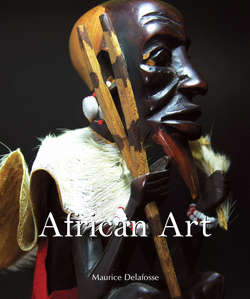Читать книгу African Art - Maurice Delafosse - Страница 16
На сайте Литреса книга снята с продажи.
Development of Negro Civilisations in Antiquity
Romans and Berbers
ОглавлениеAs for the Romans, whatever may be said of them, it seems indeed that their intervention did not take place on the other side of the Sahara and that their influence on the Negroes of Africa was nil. Their only relations with the Negroes consisted in acquiring a certain number of them as slaves, but they themselves never went to fetch them, being content to buy them from the merchants of Carthage or Numidia. It is possible that the Roman expedition which pushed farthest towards the south was that of Julius Maternus who, at the order of the Emperor Domitian, departed in 8 °CE in search of the gold mines of Sudan, but it probably did not go farther than the Aïr Mountains.
The Libyans or Berbers, more or less direct descendants – and probably very mixed – of the ancient autochthonous whites of North Africa, lived during many centuries in contact with the most northern of the Negroes. However, it does not seem that they ever had an appreciable influence on the development of Negro society, just as the influence of Libyan Berber dialects on the Sudanese languages seems to have been entirely negligible except with respect to the Hausa. In the other Negro languages along the edge of the Sahara, barely half a score of vocables of Berber origin can be discovered: sometimes the name for horse and nearly always that for camel (though not yet proved with certainty), the name of the straight sword, that of a kind of cake, one of the appellations given to the poor and those of little means, and finally the name for Easter and for sin, the two latter, moreover, having been borrowed by the Berbers from the Latin during the ascendancy of Christianity in North Africa. And that is all or almost all.
This is not as surprising as one might suppose at first sight. On the one hand, the nomad Berbers of the desert, the only ones who were and who still are in contact with the Negroes, do not pass for ever having had a very advanced civilisation: their mode of life was not adapted to it. And then, one of the general characteristics of the Berbers, as M. Henri Basset has very well shown in a recent book[6] is to adopt easily the language and certain exterior aspects of the civilisation and the religion of the foreigners who momentarily dominate them and to exercise no visible influence on this people or any other foreign population living in contact with them. Thus the Negroes of Africa owe very few obligations to their Berber neighbours, whereas they are considerably indebted to the Semites, from the distant epoch when a first current of Semitic influence made itself felt among the prehistoric natives of North Africa up to the time of the Islamisation of the same country by the Arabs and the expeditions directed from Maskat along the coast of Zanzibar, in passing by the periods of the Phoenician colonies, the splendour of Carthage and the Israelite or pseudo-Israelite immigrations.
But it is time to close this too long account devoted to the different Mediterranean and Asiatic contributions which have introduced a very important element of civilisation among the Negroes of Sudan and of East Africa, from where it spread out little by little, progressively attenuated, as far as southern Africa. Now, in a new chapter, we will come to what is known of the history, properly speaking, of the Negroes of Africa. We will begin with the State of Ghana to which allusion has already been made.
Boyo statue (Pre-Bembe).
Democratic Republic of the Congo.
Wood, height: 43 cm.
Aura Collection.
Once part of what is now the Bembe territory, the Boyo lived west of Lake Tanganyika. Specific statues are used to ask their ancestors for protection, especially in times of misfortune. The statues are kept in the hut of the village or lineage chief.
Torso (Igbo). Nigeria.
Wood, height: 66 cm.
Private collection.
Most likely part of an ensemble of life-sized painted wood figures, this fragment of a masked head on a torso may have once adorned a men’s meeting-house. The mask appears to be a calabash, the neck of which slightly projects over the forehead. The curvilinear patterns on the mask were guidelines for pigment.
The shrine and meeting-houses represented an idealised community and once contained numerous figures. Many shrine meeting-houses existed among the eastern Igbo communities near the turn of the century. Since then, most of the sculptures have been dispersed and the houses dismantled, though some have been rebuilt in cement and now have modern carvings and figures lining the walls.
6
Essai sur la litterature des Berberes, Alger, 1920.
